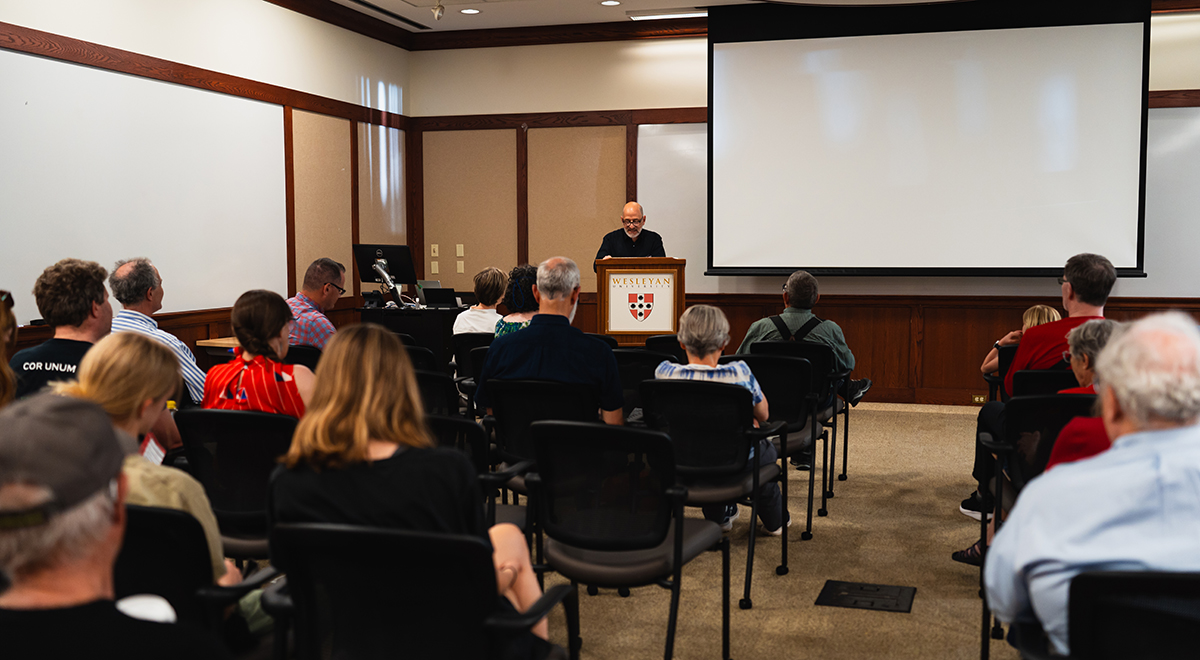Sciences at Wesleyan: An Evolution a Half-Century in the Making

When he came to Wesleyan in the 1970s in pursuit of a science education, Michael Greenberg ’76, P’14, Hon.’24 thought he’d discovered a counterpoint to the large public high school he’d attended in Brooklyn. “That was one of the things that drew me to a small college: that I might get a little more attention,” he said to an audience in Woodhead Lounge at Exley Science Center.” His hunch was correct: with the support of a department that “felt like a family,” Greenberg’s time at Wesleyan set in motion what became his career as one of the world’s most distinguished neuroscientists.
“Like many of the science students of the 1970s, I graduated imbued with a lifelong passion for learning, and a strong desire to make a contribution to the world through scientific research,” he said. “I’m quite sure that the Wesleyan of 2024 has a similar effect on science students.”
From Greenberg’s reflections on his own education to a guided tour of the 197,000-square-foot science facility under construction on Church Street, Science at Wesleyan: Where We’ve Been and Where We’re Going — a WESeminar held as part of the University’s Reunion and Commencement 2024 weekend — traced a half-century of scientific practice at Wesleyan. The picture that emerged is one of an institution that, scientifically speaking, has been punching above its weight for decades.
There are signals that this emphasis on science has been accelerating. In Fall 2023, 779 students in the Classes of 2024 and 2025, or approximately 46 percent of the total, enrolled in at least one science major, said Ruth Johnson, associate professor of biology and integrative science. This represents a sizeable increase over the roughly 29 percent of senior science majors in the Class of 1974. In just the last decade, the number of science majors on offer at the University has increased fourfold. The faculty, Johnson emphasized, are focused on lending their students a firm foundation.
“We don’t just want to provide a bucketload of information,” Johnson said. “It’s really important to us that we begin to develop their aptitudes for the different scientific disciplines, that they begin thinking about the information that we’re telling them about, that they begin working with information and working with data, so we’re developing that aptitude, that way of thinking like a scientist.”
Following Johnson’s remarks, attendees received a glimpse of what the future holds for science at Wesleyan. Alan Rubacha, assistant vice president, Construction and Infrastructure, led attendees on a tour of the under-construction science building. Upon its completion in Spring 2026, the building will house the chemistry, molecular biology, and biology departments. The structure— which incorporates some 44,000 pieces of German limestone and dozens of miles of piping — will incorporate 39 research labs and support rooms, nine teaching labs, seven classrooms, and other spaces, along with high-performance mechanical systems that represent a massive upgrade compared to the current infrastructure at Hall-Atwater. “The research that’s going to be done in this [new] building, and the research that we currently do, is dynamic and varied,” Johnson said. “This is an environment that’s going to support that.”
The future represented by the new science building harbors echoes of the past that shaped Greenberg, who studies how our brains adapt and change in response to our environment as a professor of neurobiology at Harvard University. He spoke of a challenging first year — in which struggles with biology led to a crucial pivot toward chemistry — and balancing rigorous course loads with laboratory work and part-time jobs to support his education. Greenberg talked about the professors, particularly his senior thesis advisor, who left a lasting impression on him and spurred him to pursue a future as an academic research scientist. At the core of his reminiscences, Greenberg expressed a deep gratitude for the place that instilled in him a lasting passion.
“The intellectual atmosphere, for me, at Wesleyan in the 70s, was simply amazing,” he said, “and I wish I could have stayed for another four years to take in still more of what it had to offer.”

